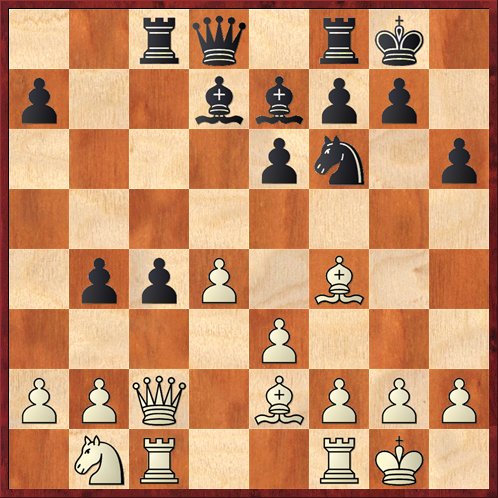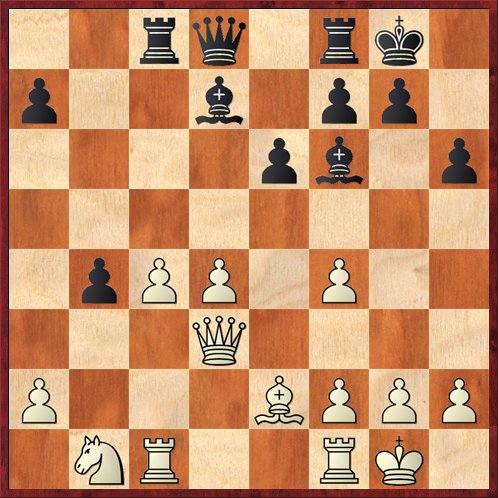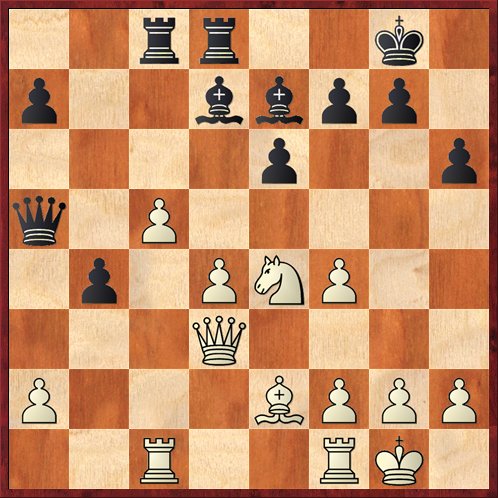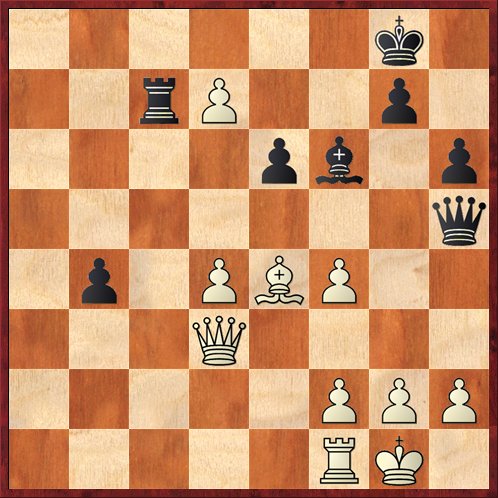As I said in my last post, I’m determined to post more often here in October than I did in September. Even if it means writing about blitz games!
Yesterday I met with Cole Ryan, whom I had not played with in two or three years. I’ve known him since he was a teenager who used to come to the Aptos Library Chess Club. Now he’s twenty-something and has just enlisted in the Navy. (He told me he’s “shipping out” in January. Where to? I asked. To Monterey, he said. For those of you who know how close Monterey is to Santa Cruz, you can appreciate the joke.)
We played about eight or nine 10-minute games, which I was very glad to do because I am soooo rusty. It’s been two or three months since I even played speed chess. The games were pretty ragged overall, as we both walked into two-movers and even one-movers. But our last two games were free of that sort of obvious blunder, and I’d like to show you how our last game went.
Black to move.
Here Cole (Black) could have had a perfectly good game according to the computer with the obvious 17. … Nd5 18. Bg3 Nb6. (If 18. Bxc4?! Nxf4 19. ef leads to the same sort of problem I had in the game — the pawns on d4 and f4 are too weak to hold. Black could easily equalize with 19. … Bb5 20. Qd3 Bxc4 21. Rxc4 Rxc4 22. Qxc4 Qd6 followed by … Rd8 and … Bf6. The d4 pawn is indefensible.)
But instead Cole plays an interesting pawn sac.
17. … c3!? 18. bc Nd5 19. c4?! …
Tempting but wrong, says the computer. (All my analysis today is courtesy of Rybka.) I should just play 19. Bg3 or 19. Be5.
19. … Nxf4 20. ef Bf6 21. Qd3 …
Black to move.
21. … Qa5?!
A slight misstep. Black should be targeting the crippled pawns in the center, as in the previous lines, with 21. … Bc6 followed by … Qd6 and … Rd8. White is totally passive and his knight is a piece of dead wood. Cole was obviously attracted by the idea of snatching White’s other crippled pawn on a2, but the trouble is that it’s hard to do that without getting the queen trapped.
22. Nd2! Rfd8 23. Ne4 …
Back, knave!
23. … Be7 24. c5?! …
Black to move.
My last move was a real speed-chess sort of move. It looks aggressive without really doing anything, and it unnecessarily commits White’s pawns to the dark squares, creating light-square weaknesses. In a tournament game I would almost certainly have chosen the more patient and flexible 24. Rfd1. But surprisingly, Rybka doesn’t see much difference between the two: it rates 24. Rfd1 at +0.08 and 24. c5 at a dead-even =0.00.
Interestingly, 24. c5 turns out to be exactly the right move from a psychological point of view. Cole has been lusting after my a2 pawn for some time, and now he thinks he can take it and get away with it.
24. … Qxa2?
It’s interesting that all the mistakes in this game are mistakes of excessive greed. That’s one reason I wanted to show the game to you.
25. Ra1 Qd5 26. Rxa7?! …
The instant I played this move, I kicked myself for not playing 26. Bf3 first. To avoid losing his queen, Black has to play 26. … Qf5 and now I can play 27. Rxa7.
However, I stopped kicking myself when I realized that Bf3 was still a strong threat.
26. … f5
A little bit reckless, but normal for blitz. I totally expected it.
White to move.
And now for my star move of the game …
27. Bf3! …
Better late than never! Incidentally, this is Rybka’s #2 choice. #1 is the clever 27. Nd6! Bxd6 28. Bf3, trapping the queen. But in that line, it’s far from clear after Black replies like 28. … Bxc5 or 28. … Bb5. The variation I chose is more forcing.
27. … ef 28. Bxe4 Qh5 29. c6! …
The point. White wins back the piece. Now Black should just play 29. … Bxc6 with only a small advantage for White, but Cole finally cracks and plays
29. … Bf6?! 30. Rxd7 Rxd7 31. cd Rc7
White to move.
What is the clearest way for White to demonstrate his advantage? Take your time. The answer is not obvious, but the title of this post might give (some of) you a clue. In all honesty I can say that in a speed game I would miss the correct combination 99 times out of 100.
The move I played was
32. Bg6? …
and I instantly regretted it because I am just chasing Black’s queen to a better location. More sensible was 32. Qa6 Rxd7 33. Qc8+ Rd8 34. Qxe6+ Qf7, but it’s still problematic because after 35. d5 Qxe6 36. de the bishops of opposite colors and passed b-pawn make it hard for White to win.
The absolute best variation, found by Rybka, is 32. d8Q+! Of course I considered this, but I didn’t get the point. The first point is that if the d-pawn is doomed anyway, it’s best to force the wrong Black piece to take it. Black would really rather have his bishop on f6 and rook on d8.
The second, tactical point is that White will follow up with 32. … Bxd8 33. d5!! If Black takes on d5, he loses: 33. … ed?? 34. Bg6! Now this move is a killer because the queen is chased away from the defense of d5. After 34. … Qh4 35. Qxd5+ Kf8 36. Re1, it’s lights out. Black can only prevent checkmate by huge loss of material.
Finally, the third, strategic point is that if Black doesn’t take on d5 and plays 33. … Rd7, then White gains the ideal square for his queen: 34. Qb5! Rd6 35. Qxb4 Rb6 36. Qc5! and Black still cannot take on d5. White has achieved all of his strategic objectives: he has won Black’s b-pawn and he still has a powerful, passed d-pawn. The game is not over yet, but White should win.
Beautiful stuff. But it’s reasonable to ask how a human could find a combination like 32. d8Q+! and 33. d5!
For fans of Hans Kmoch’s Pawn Power in Chess, the move 33. d5!! is an example of a sweeper sealer. This is a pawn move that simultaneously (1) vacates a square or opens lines that are useful for your pieces, and (2) forces your opponent to occupy a square or block a line that would have been useful for his pieces. In this case, the sacrifice (if accepted) (1) opens the e-file, enabling the rook to penetrate to e8 in lethal fashion, and (2a) takes away the square d5 from Black’s queen. And even if Black declines the sac, it still (2b) blocks the Black queen’s control of the square b5, allowing White’s queen to occupy it.
The rest of the game was a disaster, as I was running out of time and played a series of horrific moves. I will give the finish for completeness: 32. Bg6? Qd5 33. Be8?! (defending the d-pawn but taking the bishop out of action) b3 34. Rb1? (The best idea was still 34. Qa6! with the idea of Qc8! But this is already getting very dicey.) 34. … b2! (Nice move by Cole. White can’t take because of back-rank mates. Now it’s complete panic for me.) 35. h3 Rc1+ 36. Kh2 Rxb1 37. Qxb1 Qxd4 38. Qa2?? (Dropping everything. The best try was 38. Kg3.) 38. … Qxf4+ 39. Kg1 Qc1+ 40. Kh2 b1Q 41. Qxe6+ Kh7 or Kh8 (I’m not sure which Cole played, but it doesn’t matter.) 42. d8Q Qf4+ 43. g3 Qxf2 mate.
Arrgh! A pretty game ruined. But at the same time, Cole showed patient, calm defense and seized his chances at the end of the game.








{ 1 comment… read it below or add one }
I actually found 32. d8/Q+ and the followup 33. d5 after looking at the position for somewhere between five and ten minutes, so it’s not impossible for a human to solve it.
My reasoning went like this.
First I figured out that the pawn on d7 is doomed, unless you play Bg6 and Be8, but that variation leaves Black’s pieces too active. The rapid advance of the b-pawn can become quite dangerous for White and the d4 pawn also looks very weak.
After rejecting 32. Bg6 and looking at several tactical variations it gradually became clear to me that the most well-posted piece for Black is the bishop on f6 which holds his position together.
Then I noticed that after the d7 pawn falls the rook on d7 and bishop on f6 will coordinate to win the d4 pawn, so defending against that threat was the real key problem to solve.
So then I thought about the idea of saving the d4 pawn by queening the d7 pawn to decoy the bishop to d8. When I gave it a moments consideration it looked like the right move. After the bishop captures on d8 Black’s pieces no longer coordinate well.
The follow up of d4-d5 looked natural to me, opening the b3-g8 diagonal or creating a strong passer on e6 or d6 which can be backed up by the white rook and queen. I didn’t really consider other moves.
{ 1 trackback }